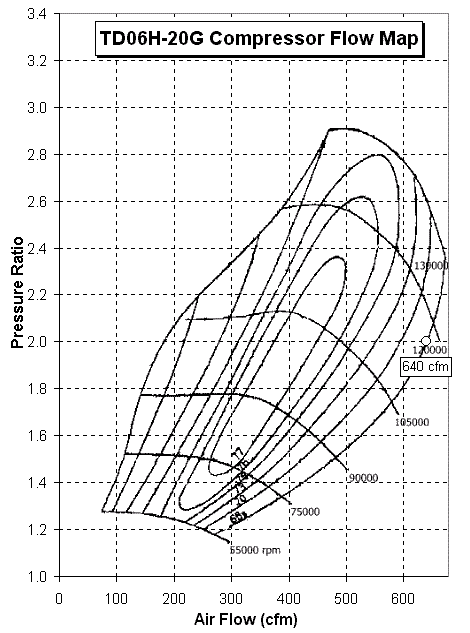- I plugged our 3 liter engine flow into the TD06-20G compressor map. I'll briefly explain how it works.
Here's a compressor map for TD06H-20G.

The elliptical circles are compressor efficiency area (how much of compressor spinning is making boost vs making heat).
The left-most curve is the surge line. You don't want the majority of engine flow falls in this area. The compress is in
unstable state in this area. If most of your engine flow falls here. The turbo is too big for the engine.
The curves staged from low to high on the map are the compressor rpm. The turbo can't boost higher than the max compressor
speed can allow.
The right-most point on the map where the least efficiency curve meets the max compressor wheel rpm is the max flow. It
means at this pressure, compressor reaches max amount of air flowed. You can increase boost beyond this pressure, but there
will be little if any more air is pumped out. You don't want your engine flow demand to fall past this point (the choke area).
If they do, then the turbo is too small for the engine. :-)
Lastly, the vertical axis is the pressure ratio. 1 pressure ratio means the air is not compressed. 2 pressure ratio means
there's 1 atmospheric boost or 14.7psi of boost at sea level. And so on... The horizontal axis is the air flow in CFM unit.
Now, lets look at how TD06-20G works with our 3 liter engine.

I plugged half of 1.5 liter flow per turbo. Each straight line represents a engine speed.
In general, some, not many engine flows fall in the surge area, mostly low rpm. Not bad. No engine flow falls in the choke
area. Good. The turbo is a little too big for the engine. :)
From the map, turbo will see some positive boost at about 3000rpm. By 4000rpm, turbo will hit about 15psi while it's still
very inefficient (65-70%).
As engine speed climbs and compressor spins faster, by 6500 engine rpm to 8500rpm, compressor gets in its max efficiency
range (77%). Oops.
If your rev limitor is 7000rpm, at 27.5psi, compressor flow matches engine flow at 550cfm or 1100cfm for both banks. That's
your max flow (if exhaust side is not restrictive, no excessive back pressure...).
If your rev limitor is 8000rpm, at 26psi, compressor flow matches engine flow at 600cfm or 1200cfm for both banks. Wow,
1200cfm. That's alot of hp. 1000+bhp or so!
Well, in conclusion, TD06-20Gs are probably a little too big for VG30DETT (something you probably already knew). They are
more of top end, max power turbos. But, spool up is not bad at all. Of course, all this is on paper. It will vary on actual
cars. :)
Next, I'll map out the flow on TD05-16G's, HKS GT2530's compressor maps.
- I finally got around to plug our engine flow into TD05-16G compressor map. So
here it is...
First of all, it's an informational guide based on the data available. It's accurate on paper. :-)
In reality, it might be and most definitely will be different depends on the cars and mods. And if your data is more accurate,
let me know, I'll correct it.
TD05-16G compressor map.

TD05H-16G has 16G compressor wheel: 46.5mm inducer and 57mm exducer wheel. Turbine side has H style
turbine wheel: 49mm exducer, 56mm inducer wheel. Mitsubishi rates TD05-16G 520cfm @ 2PR (14.7psi).
Our 3 liter engine flow plugs into 16G compressor map. Engine Flow (cfm) is approximated using the
formula,
engine flow=(Displacement) x (Volumetric Efficiency) x (Engine Speed) x (Manifold Pressure)
Volumtric Efficiency
(VE) is assumed at 100%. Those with bigger bore size, their engine will flow more.

Excuse my photoshop skills. :)
The yellow area is the 'compress surge area'. When the turbos pump more air in the motor than the motor
can physically flow through, then the air reverses back to the compressor. Kind of like closing the throttle bodies.
The orange area is the 'choke area'. When compressor wheel reaches certain speed, air in the compress
housing reaches the sonic speed. After this speed, compress speed increases, but no more additional air flow is produced.
By 3k rpm range, engine should see some positive boost in the intake manifolds. This is assumption
based on that the turbos supply the air to the engine, at that flow level, the compressor will reach certain speed and start
to produce boost.
As engine speed climbs and compressor spins faster, just before 5000 engine rpm to 6500rpm, compressor
gets in its max efficiency range (77%). Earlier than TD06-20G. But still a peaky turbo.
If your rev limitor is 7000rpm, at 24psi, compressor flow matches engine flow at 505cfm or 1010cfm
for both banks at 68% efficiency.
If your rev limitor is 8000rpm, at 21psi, compressor flow matches engine flow at 525cfm or 1050cfm
for both banks at 65% efficiency. At this point, It's pretty much the max for the turbos. It means you can increase boost
beyond 21psi, but turbos don't flow any more air (choke area). But remember, it's the motor that produce the power. As more
boost or manifolds pressure increases, the motor will make more power after 21psi.
You can see from the formula above, at the same manifold pressure, the motor produce the same power
regardless which turbos are used. That explains the misconception that at same boost, engine with bigger turbos pump out more
power.
Finally, you probably can make your own conclusion on TD05-16Gs. Good spool up. Turbos reach max efficiency
at mid to upper range of engine speed. Raising rev limitor from 7k to 8k only results about 40cfm gain for these turbos. But
turbos provide good flow all the way to the 8k red line. Very good street/road course turbos.

